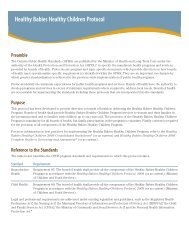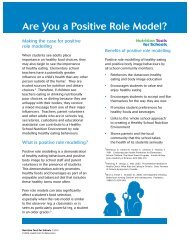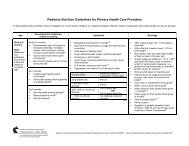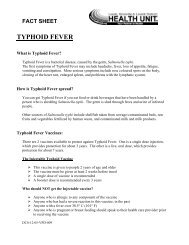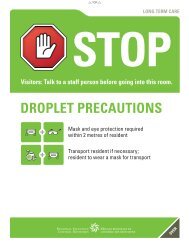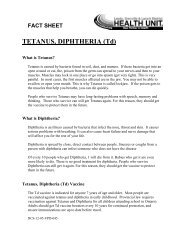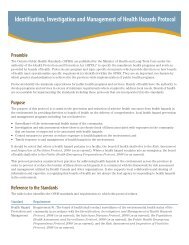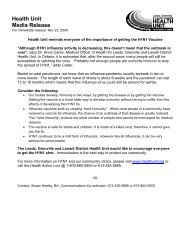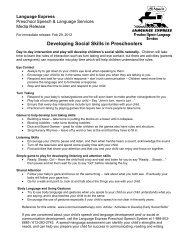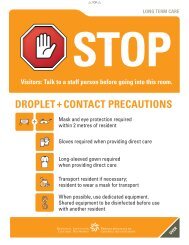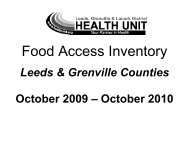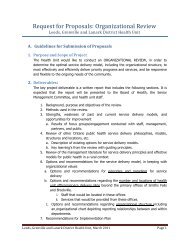Red Flags â - Leeds, Grenville and Lanark District Health Unit
Red Flags â - Leeds, Grenville and Lanark District Health Unit
Red Flags â - Leeds, Grenville and Lanark District Health Unit
You also want an ePaper? Increase the reach of your titles
YUMPU automatically turns print PDFs into web optimized ePapers that Google loves.
ABUSE<br />
EMOTIONAL ABUSE<br />
Emotional abuse includes all acts of omission<br />
or commission which result in the absence of a<br />
nurturing environment for the child. It occurs when<br />
the parent/guardian/caregiver continually treats<br />
the child in such a negative way that the child’s<br />
concept of “self” is seriously impaired. Emotionally<br />
abusive behaviour by the parent/guardian/<br />
caregiver can include constant yelling, demeaning<br />
remarks, rejecting, ignoring or isolating the child,<br />
or terrorizing the child. Emotional abuse can be the<br />
most difficult to identify <strong>and</strong> prove.<br />
The signs <strong>and</strong> indicators of abuse <strong>and</strong> neglect may<br />
include but are not limited to those that follow. It<br />
is important to realize that the presence of any one<br />
indicator is not conclusive proof that a child has<br />
been abused. In most instances, abused children<br />
will exhibit a number of behavioural <strong>and</strong> physical<br />
indicators.<br />
Physical indicators in children<br />
►► The child does not meet developmental<br />
milestones as expected<br />
►► Often complains of nausea, headaches,<br />
stomach aches without any obvious reason<br />
►► Wets or soils pants<br />
►► Is intentionally not given adequate food,<br />
clothing <strong>and</strong> proper care.<br />
►► May have unusual appearance causing<br />
humiliation or embarrassment (e.g., strange<br />
haircuts, dress, accessories)<br />
►► Bedwetting, non-medical in origin<br />
►► Child fails to thrive, e.g., poor weight gain<br />
Behavioural indicators in children<br />
►► Is unhappy, stressed out, withdrawn,<br />
aggressive or angry for long periods of time<br />
►► Severe depression<br />
►► Goes back to behaving like a young child (e.g.,<br />
toileting problems, thumb-sucking, constant<br />
rocking)<br />
►► Tries too hard to be good <strong>and</strong> to get adults to<br />
approve<br />
►► Too neat or too clean<br />
►► Tries really hard to get attention<br />
►► Tries to hurt oneself<br />
►► Criticizes oneself a lot<br />
►► Does not participate because of fear of failing<br />
►► May expect too much of him so gets frustrated<br />
<strong>and</strong> fails<br />
►► Is afraid of what the adult will do if he does<br />
something the adult does not like<br />
►► Runs away<br />
►► Has a lot of adult responsibility<br />
►► Does not get along well with other children<br />
►► Discloses abuse<br />
►► Displays extreme hesitancy in play<br />
Behaviours observed in adults<br />
who abuse children<br />
►► Often rejects, insults or criticizes the child, even<br />
in front of others<br />
►► Does not touch or speak to the child with<br />
affection<br />
►► Talks about the child as being the cause for<br />
problems <strong>and</strong> things not going as wished<br />
►► Talks about or treats the child as being different<br />
from other children <strong>and</strong> family members<br />
►► Compares the child to someone who is not<br />
liked<br />
►► Does not pay attention to the child <strong>and</strong> refuses<br />
to help the child<br />
►► Isolates the child, does not allow the child to<br />
see others both inside <strong>and</strong> outside the family<br />
(e.g., locks the child in a closet or room)<br />
►► Does not provide a good example for children<br />
on how to behave with others (e.g., swears all<br />
the time, hits others)<br />
►► Lets the child be involved in activities that<br />
break the law<br />
►► Uses the child to make money (e.g., child<br />
pornography)<br />
►► Lets the child see sex <strong>and</strong> violence on TV,<br />
videos <strong>and</strong> magazines<br />
►► Terrorizes the child (e.g., threatens to hurt<br />
or kill the child or threatens someone or<br />
something that is special to the child)<br />
►► Forces the child to watch someone special<br />
being hurt<br />
►► Asks the child to do more than he can do for<br />
himself (e.g., extreme chores)<br />
30 <strong>Red</strong> <strong>Flags</strong>: Early Identification in <strong>Leeds</strong>, <strong>Grenville</strong> & <strong>Lanark</strong> November 2007



